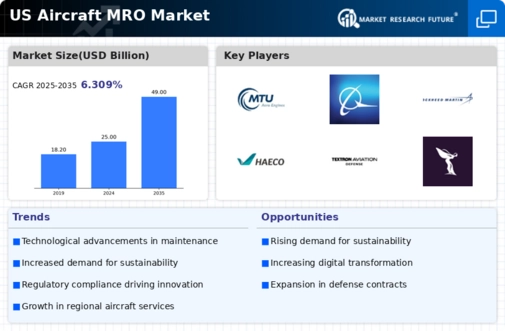The US Aircraft MRO (Maintenance, Repair, and Overhaul) Market is characterized by a robust competitive landscape influenced by increasing air traffic, an aging fleet, and emphasis on safety and efficiency. This market comprises a variety of players ranging from established aerospace manufacturers to specialized maintenance providers. The competition drives constant innovation and improvement of services, which include predictive maintenance, advanced repair techniques, and incorporation of cutting-edge technologies. Companies are increasingly focusing on expanding their service offerings, optimizing operational efficiencies, and enhancing customer satisfaction to maintain a competitive edge in this rapidly evolving sector.
Furthermore, the ongoing investments in infrastructure and the rise of digital solutions within MRO services have heightened the competitive dynamics, fostering an environment ripe for both collaboration and rivalry.Raytheon Technologies has established a significant presence in the US Aircraft MRO Market through its innovative solutions and extensive service network. The company is recognized for its engineering capabilities and focus on advancing aerospace technologies that cater to commercial, defense, and business aviation sectors. Raytheon Technologies leverages its leading-edge research and development to enhance service offerings, ensuring that customers benefit from the latest advancements in aircraft maintenance and repair.
The company’s strategic partnerships and collaborations with various stakeholders strengthen its market position and enable it to efficiently address the complexities of modern aircraft requirements. Its strong reputation within the market is bolstered by a commitment to quality and reliability, translating into customer loyalty and an expanding client base.MTU Aero Engines also plays a pivotal role in the US Aircraft MRO Market, particularly in the domain of engine maintenance and overhaul services. The company is renowned for its high-performance engine technologies, which cater to both commercial and military aviation sectors.
MTU Aero Engines offers a comprehensive range of services, including engine maintenance, repair, and component overhaul, thus ensuring that customers have sustained operational efficiency. The company’s strategic decisions concerning mergers and acquisitions have further solidified its standing in the market, allowing for the integration of advanced technologies and expanding its service capabilities. With a focus on innovation, MTU Aero Engines aims to support the sustainability of the aviation industry by developing eco-efficient solutions, all while maintaining an unwavering commitment to quality and operational excellence.





















Leave a Comment